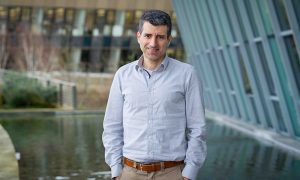
Welcome: Jordi van Gestel
Looking to understand microbial predator-prey relationships, EMBL’s newest group leader tackles a molecular ‘arms race’ in his lab

We’ve all seen the nature documentaries – a lion chasing a zebra, a spider mummifying a fly in a silky cocoon, or a grizzly bear foraging for fish in a stream. But predator-prey relationships are everywhere – even at the microbial level. Jordi van Gestel comes to EMBL Heidelberg from his most recent postdoc in San Francisco. The Netherlands native is eager to get to work as an EMBL research group leader, where his work will shed light on microbial evolution.
Tell me about your research.
My group explores the fascinating world of microbes. Each pinch of soil and drop of water hosts thousands of microbes: these widely diverse organisms, invisible to the eye, form the bedrock of our planet’s ecosystems. We study how microbes interact and evolve, by focusing on the antagonistic interactions between single-celled eukaryotic predators, called protozoans, and their bacterial prey. Predation gives rise to a perpetuating evolutionary arms race, where predators evolve ever-improving mechanisms to find and consume their prey, while prey evolve counter-adaptations to escape. Mesmerised by biology’s creativity, we explore this arms race in the lab with the goal of understanding how microbes evolve in nature.
Why is predation at this microbial level such an important thing to study?
Microbial predation is important in many ways. For instance, predation drives nutrient cycling – the back and forth of nutrients between organisms and their environment. By preying on bacteria, predators unlock resources that help other community members, like animals and plants, grow. However, microbial predation can also spark bacterial pathogenicity. As they defend against predation, bacteria can adapt in surprisingly harmful ways, such as producing toxins that find new ways to escape. By studying predation, we can potentially uncover the ecological root to this phenomenon. Lastly, with predators specialising in which prey species to consume, and prey diversifying to escape predation, wider complex predator-prey food webs result. So you could say, microbial predation represents the very start of predator-prey relationships on bigger scales.
What is the most ruthless/tenacious/scary predator you’ve observed in your research, especially in terms of that ‘evolutionary arms race’ you speak of?
Nearly all protozoan predators are voracious, consuming hundreds of billions of bacterial cells in their lifetimes. In our lab, we focus on the soil amoeba, Dictyostelium discoideum, which can clear a Petri-dish with billions of bacterial cells in a matter of days! Another spectacular predator, Lacrymaria olor, can be found in freshwater ponds. Despite being a single cell – it has a slender neck-like structure with a head that twists and turns, and devours anything it finds on the way. The list of voracious predators is really endless.
What was your impression the first time you used a microscope?
Microbes are often perceived as primitive organisms that express few simple forms and functions. But as soon as you take a microscope to delve into their alien world, you discover a spectacular diversity that far exceeds your imagination: microbes take boundless shapes, express many complex functions, and show intriguing forms of communal behaviours. Much of this alien world remains unexplored, so whenever you are staring through a microscope, there is always a chance of being surprised by the unforeseen.
What do you do for fun in your spare time?
My partner and I love to explore nature either on foot or by bike. We did many fun trips, including cycling from Switzerland to the Mediterranean and hiking on Mauna Kea in Hawaii. We are now eager to explore the many hiking and cycling trails in Heidelberg and beyond!
Since you have just moved to Heidelberg, what’s the coolest thing you’ve discovered so far?
We actually live in Mannheim, which I discovered is like the Manhattan of Germany. Just like Manhattan, downtown Mannheim has a grid-like structure, the ‘Quadrate’, with streets ordered by letters and numbers. It is buzzing on the weekend and nicely complements the picturesque city of Heidelberg.
Why does EMBL feel like the right place to do your research?
EMBL provides a truly amazing research environment, which crosses national boundaries and research disciplines and brings together an eclectic mixture of scientists from across the world. This is strikingly evident in the Developmental Biology unit as well, of which our lab is a part. The research groups work on wildly different organisms from our soil-dwelling amoebae to zebrafish. It brings together fields that would otherwise remain disconnected. Being at the intersection of molecular biology and microbial ecology, our research also perfectly connects with EMBL’s recently launched programme ‘Molecules to Ecosystems’, and it feels like a real treat to participate in the many exciting forward-looking research initiatives.


